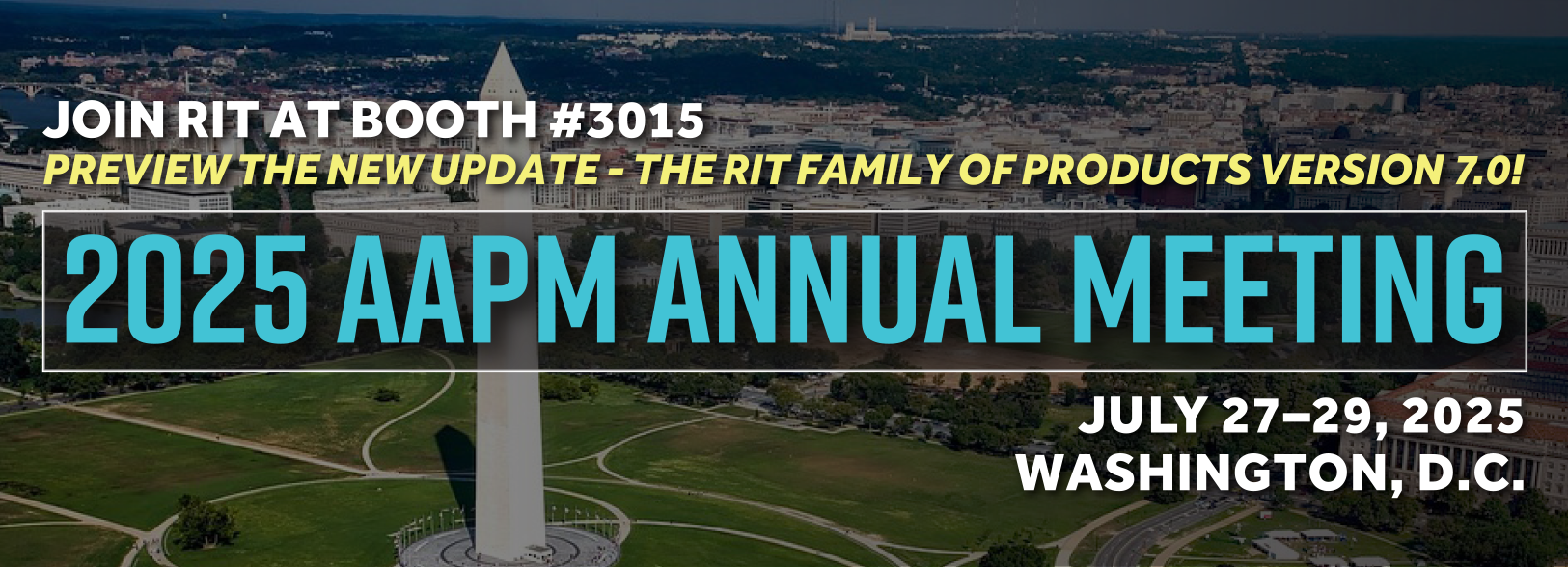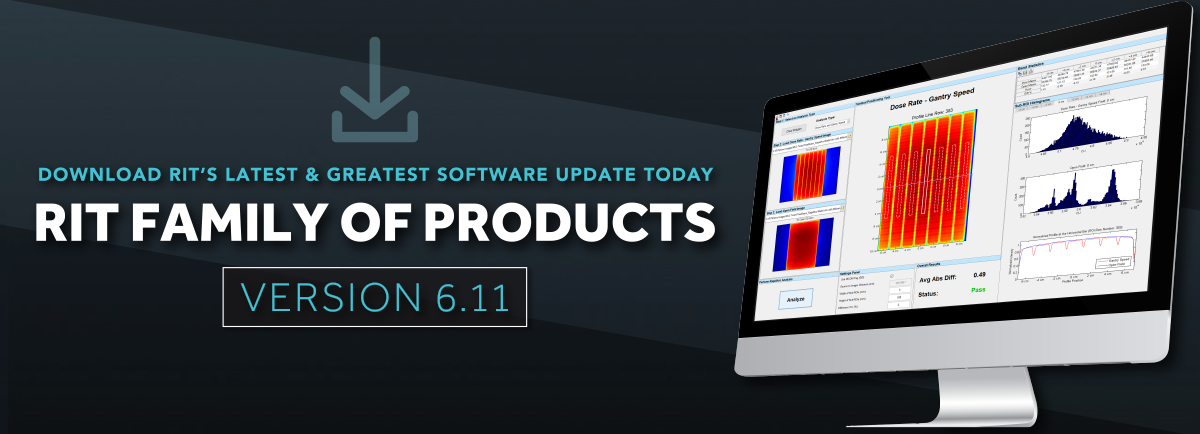MLC QA
As part of RIT’s comprehensive Machine QA capabilities, RIT software maximizes the accuracy of quality assurance for multi-leaf collimators on any linear accelerator, including Picket Fence QA, Elekta QA (MLC and Jaw QA with the Hancock Test), and Varian QA (RapidArc QA and Halcyon QA). The software allows users to track MLC performance over time and have confidence that patient treatments are proceeding as planned.
Varian MLC
Optimized TG-142 QA for Varian®
RIT provides Varian users with a standardized patient file, pre-loaded with treatment plans, covering every TG-142 test that the RIT Family of Products can analyze. Images are automatically sorted and analyzed using a built-in Cerberus script to significantly reduce QA time and lessen the burden of performing routine QA procedures. Results can be quickly and seamlessly submitted to our built-in RITtrend™ database for tracking, trending, and statistical analysis.


RapidArc® MLC
- Test 0.1: dMLC Dosimetry
- Test 0.2: Picket Fence Test vs. Gantry Angle
- Test 1.1: Picket Fence Test during RapidArc®
- Test 1.2: Picket Fence Test during RapidArc® with Intentional Errors
- Test 2: Accurate Control of Dose Rate and Gantry Speed during RapidArc® Delivery
- Test 3: Accurate Control of Leaf Speed during RapidArc® Delivery
RIT’s RapidArc QA routines support the Millennium 120, HD120 MLC, and Halcyon MLC models. This includes all RapidArc modules (Tests 0.1, 0.2, 1.1, 1.2, 2, and 3).
RapidArc® is a registered trademark of Varian Medical Systems, Inc.
RIT Auto MLC
RIT supplies ready-made picket fence plans for both Millennium and HD MLCs, allowing for fast and accurate automated MLC QA with minimal setup. Complete your MLC QA with the RapidArc and MLC Leaf Speed routines. Monitor your system’s behavior with powerful process control and statistical analysis tools by submitting your results to the RITtrend™ database system.

Varian Halcyon® MLC QA
RIT software is compatible for verification and quality assurance of the Varian Halcyon machine MLCs, used for image-guided radiation therapy (IGRT). Easily perform MLC QA, including a picket fence and comprehensive RapidArc analysis of the Halycon machine. RIT software will easily interface with the machine's dual-layer multi-leaf collimator.
Halcyon® is a registered trademark of Varian Medical Systems, Inc.
SRS/SBRT QA
Isocenter Optimization Routine (3D Winston-Lutz)
Automatically process a set of EPID Winston-Lutz images to give a fast, accurate measurement of isocenter position. RIT’s version of this classic test allows you to use 3 to 16 images, not only giving you an accurate measurement of isocenter displacement, but also an error estimate determining the wobble around the isocenter and any ball setup error. Increased angle flexibility allows you to mimic more clinically relevant angles to determine isocenter at specific treatment configurations
Eliminate your need for films, and increase your accuracy by using the all patented Virtual Starshot, reconstructed using a set of Winston-Lutz images!Patents: US 9192784, JP 6009705, CA 2918045, and other international patents pending.

Imaging Tests
CATPHAN® 504 & 604 For Varian OBI
RIT’s CATPHAN® analysis has been carefully designed to provide automated CBCT QA for the Varian OBI.
Analyze all relevant slices of the CATPHAN® 504 or 604 in one easy step, and quickly get comprehensive reports for:
- HU Constancy and linearity
- Geometric Accuracy
- Slice thickness
- Spatial Resolution
- Uniformity and noise
Catphan® is a registered trademark of The Phantom Laboratory.
Planar MV (EPID) Imaging
For EPID, RIT provides quality imaging QA and performs all tests recommended in TG-142. Results are accurate and consistent. Quickly perform measurements of resolution, contrast, noise, uniformity, and geometric scaling all in one image. RIT software supports Las Vegas, QC-3 (now capable of analyzing magnified images), and PTW EPID phantoms. TG-158 and Varian QA acceptance criteria have been added for the Las Vegas EPID.
Planar kV Imaging
RIT software is designed to support vendor-supplied phantoms for planar kV imaging. Using your Leeds TOR-18 FG phantom, supplied by Varian, you can quickly and easily meet all TG-142 recommendations for planar kV imaging QA in a single exposure. Results are consistent, quantitative, and repeatable, and can easily be tracked in RITtrend™.
IGRT / kV-MV Coincidence
Perform precision IGRT daily QA with the Standard Imaging ISOCube phantom and RIT software. Quickly and quantitatively perform positioning-repositioning, laser alignment, field size checks, kV and MV coincidence measurements, CBCT isocenter coincidence, ODI accuracy, and the 6 Degree-of-Freedom couch test.

Other TG-142 Relevant Tests
Bayouth MLC Test
Analyzes MLCs that require leaf gaps between banks.
Radiation vs. Light Field Alignment
Perform quick easy EPID-based radiation vs. light field alignment.
Beam Profiles
Quick and easy measurements for star shots, flatness and symmetry, FWHM, penumbras, depth-dose curves, and more.Elekta MLC
Hancock Tests (Leaf and Jaw Positional Accuracy)

MLC and Jaw QA
The Hancock Test (2-Image Test, 4-Image Test, and With Backup Jaw Test) makes MLC and Jaw QA simple for Elekta machines. The test follows a simple image acquisition procedure on the iViewGT™ system, with automatic processing and reporting by RIT. This test has versions specifically-formatted for the Agility™ MLC head and the MLCi2 head. The Hancock Test encompasses several mechanical tests, including MLC position accuracy, jaw position accuracy, and takes into consideration iViewGT™ imager position movement and collimator rotation isocenter walkout. The Hancock Test results can be used as input data for adjusting the MLC and jaw calibration in the Elekta TCS (Treatment Control System). The RIT Hancock Test is the only system that meets the TG-142 requirement to measure backup jaw position relative to leaf position. The RIT system easily and seamlessly supports JPEG and HIS images from iViewGT™.
Track your results in the RITtrend™ database, or export them to PDF or Excel formats.
iViewGT™ and Agility™ are trademarks of Elekta, AB.
SRS/SBRT QA
Isocenter Optimization Routine (3D Winston-Lutz)
The RIT Family of Products come equipped with an automated 3D Stereotactic Alignment routine, giving you a fast and accurate measurement of isocenter accuracy. Using only a set of 3 to 16 EPID Winston-Lutz images, the RIT system will calculate deviations between radiation and mechanical isocenter, determine ball/BB setup error and suggest couch alignment adjustments to optimize your system’s accuracy. Additionally, this routine enables individual component (gantry, collimator, couch) characterization to better understand distinct contributions to isocenter deviation, giving insight into adjustments that can be made to improve delivery performance, if needed. Increased angle flexibility allows you to mimic more clinically relevant angles to determine isocenter at specific treatment configurations. Elekta Unity machine analysis is supported.
Eliminate your need for films and increase your accuracy using Virtual Star Shot* with ANY combination of angles, reconstructed using a set of Winston-Lutz images in it’s new, dedicated window!
*Patents: US 9192784, JP 6009705, CA 2918045, and other international patents pending.


Isocenter Optimization for Elekta Unity:
RIT’s Isocenter Optimization routine supports analysis on the Elekta Unity machine, an MR-LINAC machine that combines diagnostic quality MR imaging with a linear accelerator. Elekta users can now utilize RIT’s most popular analysis routine to automatically process a set of EPID Winston-Lutz images for fast, sub-millimeter accuracy of isocenter position.
Elekta Leaf Speed Analysis
RIT offers enhanced MLC QA for Elekta machines, allowing for fast and accurate automated analysis, with minimal setup.
- The Leaf Speed Analysis routine measures the consistency and accuracy of the MLC leaf speeds as they traverse the imager.
- All measurements are made on your EPID, just like your treatment deliveries. Log files are not used, allowing for universal access.

Imaging Tests
CATPHAN® 503 for Elekta
RIT’s CATPHAN® analysis has been carefully designed to work with images from Elekta’s XVI system and to provide test results equivalent to Elekta’s Customer Acceptance Tests for:
- Low Contrast Visibility
- Resolution
- Uniformity
CATPHAN® is a registered trademark of The Phantom Laboratory.
Planar MV (EPID) Imaging
For EPID, RIT provides quality imaging QA and performs all tests recommended in TG-142. Results are accurate and consistent. Quickly perform measurements of resolution, contrast, noise, uniformity, and geometric scaling all in one image. RIT software supports Las Vegas, QC-3 (now capable of analyzing magnified images), and PTW EPID phantoms. TG-158 and Varian QA acceptance criteria have been added for the Las Vegas EPID.
Planar kV Imaging
RIT software is designed to support vendor-supplied phantoms for planar kV imaging. Using your Leeds TOR-18 FG phantom supplied by Elekta, you can quickly and easily meet all TG-142 recommendations for planar kV imaging QA in one exposure. Results are consistent, quantitative, and repeatable, and can easily be tracked in RITtrend™.
IGRT / kV-MV Coincidence
Perform precision IGRT daily QA with the ISOCube™ phantom and RIT software. Quickly and quantitatively perform positioning-repositioning, laser alignment, field size checks, kV and MV coincidence measurements, CBCT isocenter coincidence, ODI accuracy, and the 6 Degree-of-Freedom couch test. Analysis of Penta-Guide phantom is now also supported for kV/MV/CBCT image coincidence.
ISOCube™ is a trademark of IMT, Inc.
Other TG-142 Relevant Tests
Bayouth MLC Test
- Analyzes MLCs that require leaf gaps between banks.
Radiation vs. Light Field Alignment
- Perform quick easy EPID based radiation vs. light field alignment.
Beam Profiles
- Quick and easy measurements for star shots, flatness and symmetry, FWHM, penumbras, depth-dose curves, and more.
CyberKnife M6 MLC
CyberKnife® TG-135 QA
Fully-Automated M6 MLC Test
RIT's fully-automated “Garden Fence” MLC test, included in RIT Complete and RITG135, greatly increases the efficiency of MLC tests for CyberKnife® units with a M6 multi-leaf collimator. According to experts at Accuray®, you can save an average of 30 minutes per film. The MLC tests are consolidated into a single software package that will automatically crop the image, automatically align the image, perform automatic orientation of any images that are rotated or flipped, and automatically detect any leaves, eliminating any need for template files.
CyberKnife® is a registered trademark of Accuray, Inc.

Other MLC QA Options
Varian® DMLC Test Pattern Analysis
RIT software automatically analyzes the 9 Varian dMLC test patterns to determine proper MLC operation. Quantitative results and Pass/Fail results are reported. These tests evaluate positional accuracy of the leaves, kinetic properties (including leaf speed stability), leaf acceleration, and fractional dose delivery. This method utilizes test patterns for step-and-shoot and sliding window techniques.
- Varian MLC Test 1: Picket Fence
- Varian MLC Test 2: Synchronized Segmented Stripes
- Varian MLC Test 3: Non-Synchronized Segmented Stripes
- Varian MLC Test 4: X Wedge Single Image & Composite
- Varian MLC Test 5: Y Wedge Single Image & Composite
- Varian MLC Test 6: Pyramid Single Image & Composite
- Varian MLC Test 7: Complex A
- Varian MLC Test 8: Complex B
- Varian MLC Test 9: Continuous Stripes
Generic Picket Fence (Memorial Sloan Kettering Picket Fence)
The Generic Picket Fence Test uses the same template and analysis as the TG-50 Picket Fence Test and the Varian MLC Test 1 (Picket Fence).
Bayouth MLC Analysis
The Bayouth MLC test will analyze MLCs that require leaf gaps between banks. The leaf positions are measured from the central axis. A graphical display is created to indicate which leaves are out of their expected position and which exceed the tolerances established by the user.
Setup MLC Leaf Template
Creation of leaf templates is required for the Generic Picket Fence Test, Bayouth MLC Test, TG-50 Picket Fence Test, MSK Leaf Test, Varian MLC Test 1 (Picket Fence), and Varian MLC Test 9 (Continuous Stripes). The purpose of the leaf template setup is to allow the software to analyze all leaves in a single operation.
MLC Transmission Analysis (TG50 Recommended)
The TG-50 MLC Transmission analysis can be used to automatically measure mid-leaf and inter-leaf transmission.
TG50 Picket Fence
The TG-50 Picket Fence test uses the same template and analysis as the Generic Picket Fence Test and the Varian MLC Test 1 (Picket Fence).
MSK Leaf Test
MSK Leaf test uses the same image as Varian MLC Test 9 (Continuous Stripes).
RIT Products For MLC QA Solutions

All of RIT's therapy products in one convenient and comprehensive package.
The ideal software package for:
Medical physicists that perform various types of QA/QC measurements on a variety of machines, including both linear accelerators and imaging devices.
Quality Assurance:
Patient QA | Machine QA | MLC QA | Imaging QA

The original RIT product package that combines Machine QA (including MLC QA) and Patient QA.
The ideal software package for:
Medical physicists that require a single QA software solution for their linear accelerator(s) and for intensity-modulated radiation therapy (IMRT) procedures.
Quality Assurance:
Patient QA | Machine QA | MLC QA

A package specifically-designed to perform every imaging and machine QA test required in TG-142.
The ideal software package for:
Medical physicists that need to thoroughly and accurately complete daily, monthly, and annual QA on their linear accelerator(s).
Quality Assurance:
Machine QA | MLC QA | Imaging QA

A comprehensive test suite for CyberKnife® and all robotic radiosurgery, in accordance with TG-135.
The ideal software package for:
Medical physicists and/or centers that use a only a CyberKnife® machine, specifically one with an M6 collimator, performing daily, monthly, and annual QA.
Quality Assurance:
Machine QA | MLC QA

RIT’s basic film analysis package for patient QA and partial machine QA measurements.
The ideal software package for:
Medical physicists that require a single software solution for film dosimetry and basic QA.
Quality Assurance:
Patient QA | Machine QA (Partial) | MLC QA (Partial)



